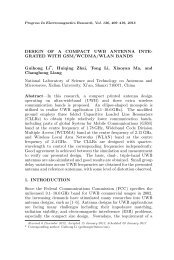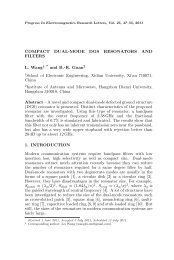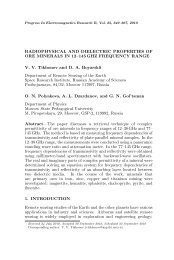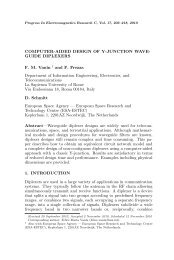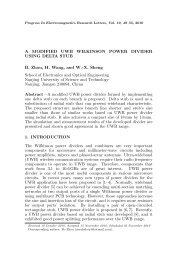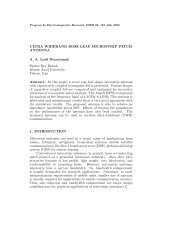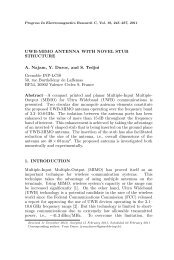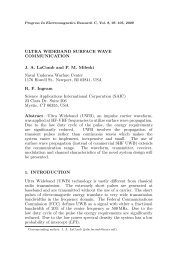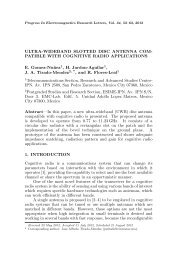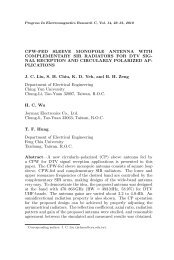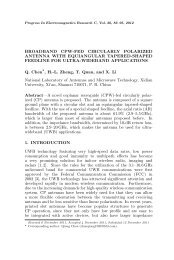PDF File (979 KB) - PIER
PDF File (979 KB) - PIER
PDF File (979 KB) - PIER
You also want an ePaper? Increase the reach of your titles
YUMPU automatically turns print PDFs into web optimized ePapers that Google loves.
134 Angermann and Yatsyk<br />
nonlinear integral equations. The solution of these nonlinear problems<br />
was obtained rigorously in a self-consistent formulation and without<br />
using approximations of the given field, slowly varying amplitudes etc..<br />
The approximate solution of the nonlinear problems was obtained<br />
by means of solutions of linear problems with an induced nonlinear<br />
dielectric permeability. The analytical continuation of these linear<br />
problems into the region of complex values of the frequency parameter<br />
allowed us to switch to the analysis of spectral problems. In the<br />
frequency domain, the resonant scattering and generation properties of<br />
nonlinear structures are determined by the proximity of the excitation<br />
frequencies of the nonlinear structures to the complex eigen-frequencies<br />
of the corresponding homogeneous linear spectral problems with the<br />
induced nonlinear dielectric permeability of the medium.<br />
We presented a collection of numerical results that describe<br />
interesting properties of the nonlinear permittivities of the layers as<br />
well as their scattering and generation characteristics. In particular,<br />
for a nonlinear single-layered structure with decanalising properties,<br />
the effect of type conversion of generated oscillations was observed.<br />
We were able to show the characteristic dynamical behaviour<br />
of the relative Q-factor of the eigenmodes and the energy of higher<br />
harmonics generated by canalising as well as decanalising nonlinear<br />
layers. For an increasing amplitude of the exciting field, an increase<br />
of the generated energy in the higher harmonics is accompanied by a<br />
monotonic decrease of the relative Q-factor of the eigenoscillations.<br />
The results demonstrate the possibility to control the scattering<br />
and generating properties of a nonlinear structure via the intensities<br />
of its excitation fields. They also indicate a possibility of designing<br />
a frequency multiplier and other electrodynamical devices containing<br />
nonlinear dielectrics with controllable permittivity.<br />
ACKNOWLEDGMENT<br />
This work was partially supported by the Visby Program of the<br />
Swedish Institute and by the joint Russian-Ukrainian RFBR-NASU<br />
grant No. 12.02.90425-2012.<br />
REFERENCES<br />
1. Agranovich, V. and V. Ginzburg, Spatial Dispersion in Crystal<br />
Optics and the Theory of Excitons, Interscience, London, 1966.<br />
2. Angermann, L., Y. V. Shestopalov, and V. V. Yatsyk, “Modeling<br />
and analysis of wave packet scattering and generation for a<br />
nonlinear layered structure,” Multiphysics Modeling in Microwave<br />
Power Engineering, 21–26, E. M. Kiley and V. V. Yakovlev (eds.),




